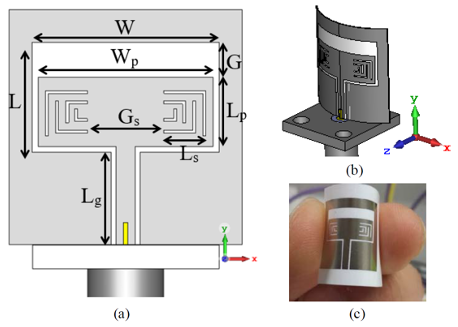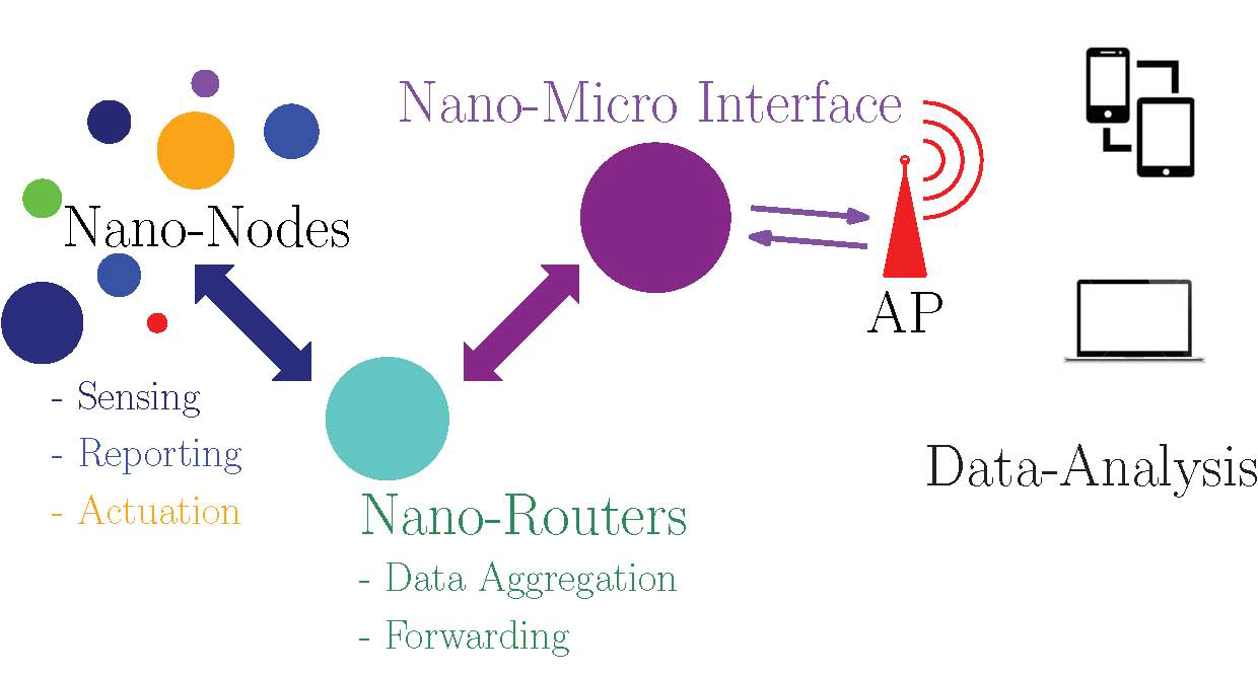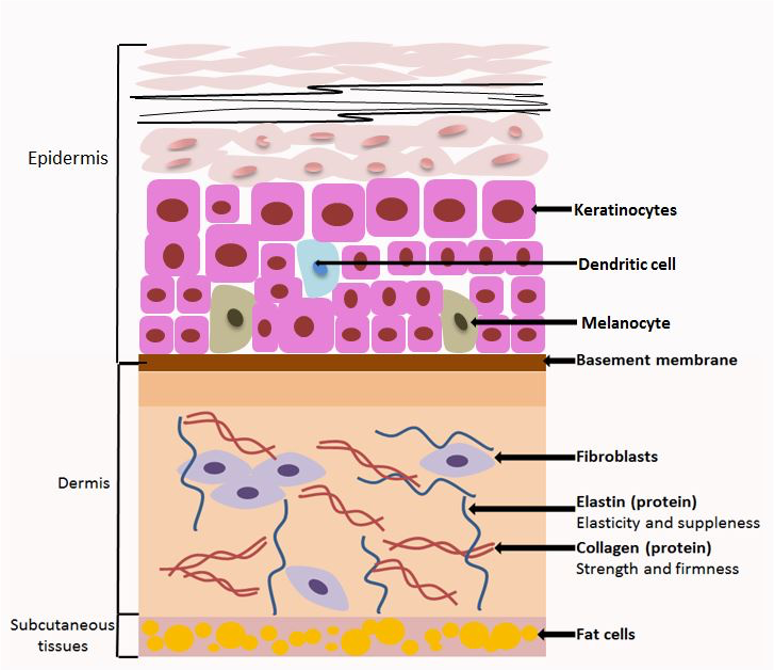Body-Centric Wireless Communications
The development of wearable computer systems has been growing rapidly. These are becoming smaller and more lightweight; no one wants to wear a bulky and heavy computer all day! We will soon see a wide range of unobtrusive wearable and ubiquitous computing equipment integrated to into our everyday clothes. In a possible wearable computer, the monitor/display would be on a pair of glasses, the keyboard worn on the wrist, and the motherboard worn on the waist. It is undesirable to use bulky cables to connect these devices, so communication will be wireless, using an antenna.
The human body is an uninviting and often hostile environment for a wireless signal. Compact yet efficient antennas need to be fully characterized and integrated with the RF transceiver. Some of these are conformability and immunity to frequency and polarization detuning. It is important to understand material properties of fabrics and potential use of microwave metamaterials to minimize the specific absorption rate (SAR).
We are working on the important issue of the design of such an antenna. We are particularly considering the following issues:
- The antenna itself must be small and lightweight, since it is part of a lightweight device;
- The small size of the antenna must not reduce its performance;
- The antenna structure must be designed to have limited radiation power in the direction of the wearer, to minimize possible health problems;
- The transmission power must be low, to prolong battery life and hence operating time.
- Textile conformal antennas to provide user-friendly solutions
- Surface guided wave antenna to improve on-body communications
- Radio propagation in complex environments and considering dispersive human tissues
- System-level modelling for potential narrowband and ultra wideband communication systems.
- Covering a wide range of frequecy up to Terahertz for nano-scale networks
Wearable Sensor Antennas have to be compact and easily integrated. They should be immuned from de-tuning and performance degradation due to surrounding components and when placed on the body. They should have high efficiency to achieve maximum radiated power to enlarge coverage area specifically for communication between body mounted devices and base units/access points. It is also needed in the wireless sensor antenna design to overcome shadowing problems caused by the human body and the dynamic environment.
Antennas and Propagation for Wireless Implants
Wireless Implants provide flexibility to the patience and the surgeon in terms of replacement and long lifetime. They have advantages of maintaining constant availability and ease of operation, which are required for future patient monitoring and diagnosis systems. Applications include but not limited to:
- Accurate drug delivery.
- Non-Invasive Endoscopy.
- Patient diagnosis and locator.
- Muscle stimulator.
- Brain signals analysis and control.
The group has had many successful collaborations including an ongoing research with the National Research Centre for Bowel Disease and Barts and The London on localisation and tracking wireless endoscope for future efficient patient-centric endoscopy.
UWB Antennas and Their Applications in the Home Environment
UWB provides High capacity, Multipath robustness, Fine time resolution for accurate delay estimate, Low transmission power, Inexpensive systems and Multi-access. Dispersion of human tissues across the frequency band needs to be considered in on-body antenna and propagation characterisation. Usually, non-dispersive antennas are required for optimum performance with radiation that minimises path loss across UWB band. Since UWB is Impulse Radio technology, received pulse shape and property is of great importance.

Wearable Antennas and Sensors
The group has been working in collaborations with material scientists at QMUL, The Royal College of Art, Loughborough University and Nottingham University to push the boundaries for textile based antennas and EM devices and structures going beyond wearable antennas to complex metamaterials. Activities inlcude Graphene-based soft antennas with efficient performance for near field and medium range application to be first screen print and tested in our labs.


Nano-scale body-centric communications and networks at THz
With the development of nanotechnology, the idea of connecting nano-devices to conduct complicated tasks and communicate the information collected by these devices was a natural progression in order to complete the overall picture of a new generation of connected devices. As a consequence, nano-networks were proposed by the IEEE standardization group (P1906.1 - Recommended Practice for Nano-scale and Molecular Communication Framework, which the principal supervisor is a member of) and therefore the need for nano-communication was a necessity. Nano-networking is the study of communication among devices and/or entities – manmade, biological, and hybrid – with very small dimensions; challenging physical features of this communication environment make analysis and system design very different from conventional communication systems. Nano-networking is a rapidly emerging discipline, but as yet (1) emerging technology trends and important open problems in this area are unclear; and (2) new industrial applications need to be identified. Although we have a comprehensive understanding of wireless body sensors and other cellular networks, how nano-devices communicate inside or around the body is still an open research challenge. It is generally accepted that molecular communication is the most promising method to transfer information between nano-devices when it comes to bio-applications. But is there any possibility to adopt the electromagnetic (EM) communication paradigm at nano-scale? Adopting EM communication will create an easier path for larger networks and also allow the use of varying technologies and data rate based on the scenario of concerned.
The group has been active in recent years in theoretical, numerical and experimental research focused on the proof of concept and validation of the down scaling of the body-centric wireless communication networks to the nano-scale and enjoyed grant funding from national and international research councils, industries and chartities. The group collaborated with leading experts from USA, UK, EU, Japan, Singapore, Qatar, UAE and many more. The group was also a lead contributor to the IEEE P1906.1 Nano-scale and Molecular Communication Framework and also an active member of the IEEE SC THz standardisation group.
The applications range from comprehensive healthcare monitoring, localised tissue detection of deformations (e.g. skin biological deformation monitoring), chemical compound recognition and high data rate confined and secured next generation communication.


Highlights and Research Outcomes
- The group has published 5 books, more than 12 book chapters and more than 500 substantial journal and refereed conference papers on Body-Centric Wireless Communications.
- This work is in collaboration with many academic partners (Imperial College London, University of Birmingham, etc.) and industrial collaborators (DSTL, Philips Research, GE Global Research, Toumaz Technologies Ltd., etc.)
- The group has organised/co-organised 5 workshops related to body-centric wireless networks sponsored by the European School of Antennas, and more than 5 focused seminars.
- Academics in the Antennas Group involved in body-centric research have been invited to deliver special talks and keynotes in many international conferences organized by the IEEE and IET
- Prof. Yang Hao was elected as IEEE Fellow in 2013 in recognition of his contributions to body-centric wireless communications.
- Various media appearances and international exposure related to wearable electronics.
Selected Research Grants and Projects
- PAMBAYESIAN: PAtient Managed decision-support using Bayesian networks, EPSRC Intelligent Technologies for Collaborative Care Fund (Total for consortium £1.6m, July 2017 – June 2021)
- Numerical Analysis and In-vitro Demonstrator of Small-scale Communication Networks for Healthcare Monitoring Applications – Qatar National Research Foundation NPRP fund with Texas A&M University at Qatar (£550k, Feb 2015–Jan 2018)
- EPSRC Off-campus Business Engagement Fund– EPSRC funding through QMUL internal competition (£12.5k, Jan–Apr 2015)
- EPSRC CDT Capital Equipment Fund for Media and Arts Technology Doctoral Training Activities, (£314k, Sept 2014)
- UWB Antenna Front-end Solutions for Localisation and Tracking, Consultancy for Sportable Technologies Ltd., (September 2019 – April 2020)
- MASH: Millimetre-wave AI-enabled Smart Healthcare monitoring, Innovate UK – Lead by NodeNS Medical Ltd. (Total of £31k, February – September 2019)
- Atrial Fibrillation Prediction Using WBAN-ECG Monitoring System, Abu Dhabi Department of Education and Knowledge (ADEK) Award for Research Excellence 2018 – Lead by Al Ain University of Science and Technologyand in collaboratrion with University of Glasgow UK (Total of £90k, January 2019 – December 2020)
- Sensing the Human Skin for Medical Diagnostic and Prevention in Personalised Healthcare Applications, Abu Dhabi Department of Education and Knowledge (ADEK) Award for Research Excellence 2017 – Lead by UAE University and in collaboratrion with University of Glasgow UK (Total of £90k, January 2018 – December 2019)
- Design, fabrication and ex vivo validation of a body-centric localisation and tracking system for use in a robotised wireless capsule endoscope – QMUL Life Sciences Initiative Proof of Concept Fund (£50k, January – December 2018)
- PATRICIAN: New Paradigms for Body Centric Wireless Communications at MM Wavelengths, in total, £1.2M EPSRC, with University of Birmingham and Durham (2011.1 – 2014. 12)
- Reduction of Energy Demand in Buildings through Optimal Use of Wireless Behaviour Information (Wi-be) Systems”, in total £600K, EPSRC, with University of Nottingham, Reading (2010.8 – 2013.7)
Selected Recent Publications
- Khan AN, Ihalage AA, Ma Y, Liu B, Liu Y, Hao Y (2021) Deep learning framework for subject-independent emotion detection using wireless signals. PLoS ONE 16(2): e0242946. https://doi.org/10.1371/journal.pone.0242946
- Akram Alomainy, Ke Yang, Muhammad A. Imran, Xin-Wei Yao, Qammer H. Abbasi (eds.), "Nano-Electromagnetic Communication at Terahertz and Optical Frequencies: Principles and Applications", The Institute of Engineering and technology (IET), November 2019. ISBN-10: 1-78561-903-9 and ISBN-13: 978-1-78561-903-8
- Qammer H. Abbasi, Masood Ur Rehman, Khalid Qaraqe and Akram Alomainy (eds.), "Advances in Body-Centric Wireless Communication: Applications and State-of-the-art" , The Institute of Engineering and technology (IET), July 2016. ISBN: 978-1-84919-989-6
- K. Yang, D. Bi, Y. Deng, R. Zhang, M. M. Ur Rahman, N. Abu Ali, M. A. Imran, J. M. Jornet, Q. H. Abbasi, and A. Alomainy, "A Comprehensive Survey on Hybrid Communication in Context of Molecular Communication and Terahertz Communication for Body-Centric Nanonetworks", in IEEE Transactions on Molecular, Biological and Multi-Scale Communications, vol. 6, no. 2, pp. 107-133, Nov. 2020, doi: 10.1109/TMBMC.2020.3017146.
- Robel, M.R.; Ahmed, A.; Alomainy, A.; Rowe, W.S.T., "Effect of A Superstrate on On-Head Matched Antennas for Biomedical Applications", Electronics 2020, 9, 1099.
- I. Ibanez-Labiano, M. S. Ergoktas, C. Kocabas, A. Toomey, A. Alomainy, E. Ozden-Yenigun, "Graphene-based Soft Wearable Antennas", Applied Materials Today, Volume 20, September 2020, 100727 (https://doi.org/10.1016/j.apmt.2020.100727).
- W. Belaoura, K. Ghanem, M. A. Imran, A. Alomainy and Q. H. Abbasi, "A Cooperative Massive MIMO System for Future In Vivo Nanonetworks", in IEEE Systems Journal, doi: 10.1109/JSYST.2020.2995671.
- Ibanez-Labiano, I.; Alomainy, "A. Dielectric Characterization of Non-Conductive Fabrics for Temperature Sensing through Resonating Antenna Structures", Materials 2020, 13, 1271.
- A. Rizwan, N. Abu Ali, A. Zoha, M. Ozturk, A. Alomaniy, M. A. Imran and Q. H. Abbasi, "Non-invasive Hydration Level Estimation in Human Body using Galvanic Skin Response" in IEEE Sensors Journal, vol. 20, no. 9, pp. 4891-4900, 1 May1, 2020, doi: 10.1109/JSEN.2020.2965892.
- R. Zhang, K. Yang, B. Yang, N. A. AbuAli, M. Hayajneh, M. P. Philpott, Q. Abbasi, A. Alomainy, "Dielectric and Double Debye Parameters of Artificial Normal Skin and Melanoma", J Infrared Milli Terahz Waves 40, 657–672 (2019). https://doi.org/10.1007/s10762-019-00597-x.
- M. Ilyas, O. N. Ucan, O. Bayat, A. A. Nasir, M. A. Imran, A. Alomainy, Q. H. Abbasi, "Evaluation of Ultra-wideband In-vivo Radio Channel and Its Effect on System Performance", Trans Emerging Tel Tech. 2019;30:e3530.
- P. Leelatien, K. Ito, K. Saito, M. Sharma and A. Alomainy, "Numerical Channel Characterizations for Liver-Implanted Communications Considering Different Human Subjects", IEICE Transactions on Communications, Article ID 2018EBP3050, October 2018.
- A Pellegrini, A Brizzi, L Zhang, K Ali, Y Hao, et al, Antennas and Propagation for Body-Centric Wireless Communications at Millimeter-Wave Frequencies: A Review [Wireless Corner], Antennas and Propagation Magazine, IEEE 55 (4), 262-287.

